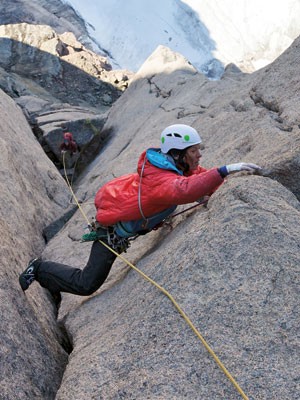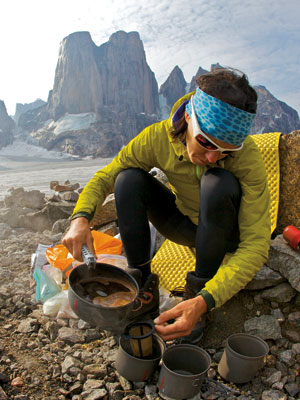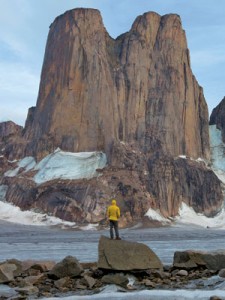Baffin Island Adventure
In Norse mythology, Asgard was the Realm of the Gods. I had feasted on the divine stone of both of its south and east sides, with Chris Brazeau in 2009, yet I was hungry for more, as I considered what we'd climbed to be some of the finest alpine rock I'd ever experienced.

In 2013, Joshua Laviagne, Ines Papert and Jon Walsh established Sensory Overload on Mount Asgard.
By Jon Walsh
Joshua Lavigne, Ines Papert and I are like-minded in many ways. In particular, we share similar dreams of traveling to remote venues of ice and stone, where spectacular unclimbed routes can be attempted. These dreams provide nourishment for the soul, just as meals do for the body. New-routing is also an addiction for us. With this in mind, it was easy to convince them into joining me for an attempt at the unclimbed, 1200 m northwest buttress of Mount Asgard’s south tower, in Auyuittuq National Park, Baffin Island. It was a dream I had carried since I first saw a photo of it, lit by the setting sun, in Mark Synnott’s 2008 guidebook, with no route lines anywhere close to it. In Norse mythology, Asgard was the Realm of the Gods. I had feasted on the divine stone of both of its south and east sides, with Chris Brazeau in 2009, yet I was hungry for more, as I considered what we’d climbed to be some of the finest alpine rock I’d ever experienced. With valuable details learned from the previous visit, we began the planning and preparations to free-climb one of the biggest unclimbed granite walls in North America.
Before we knew it, months had passed, and we grew giddy with excitement as the moment came to leave the civilized world. Three flights and a chartered boat ferry up the iceberg strewn Pangnirtung Fiord landed us at the mouth of Weasel River Valley. Shouldering heavy packs, the arduous approach along the banks of the Weasel began. Flocks of geese floated by as the northern landscape rolled out before us. As grassy meadows softened our stride, an arctic fox with a hare in its mouth, kept a safe distance as we passed. Further upstream, the hiking became more strenuous as the trail negotiated sandy dunes, steep moraines and raging creeks that descended from nearby glaciers. Some were desperately deep, numbingly cold, and serious injury seemed imminent if a slip were to occur. As lungs filled with fresh arctic air, our awareness to the surroundings became more acute. Massive black and red boulders studded the vast landscape, while bright purple fireweed stretched from the soft tundra towards the warming rays of the sun. Massive glaciers hung between the sharp granite spires, and their melt-waters cascaded down the steep mountainsides all around, providing welcome distraction from the physical slogging we assumed.

On the morning of the third day we reached our cache that had been placed by snow machine several months earlier, about 45 km from the trailhead, a strategy that saved us several days of ferrying loads. After sorting the gear, we maxed out our packs and proceeded up a steep moraine towards the Turner Glacier. Despite the hurt we felt in our bodies, we pushed on until we found a strip of rock with a front row seat of the main objective: Mount Asgard’s mighty nordwand. Here we could observe the face comfortably for a couple of nights before getting on it. This base- camp was equally as close to another attractive peak we were interested in – Mount Loki. The next day we dropped back down to the cache and hiked up another crippling load. It had been over 80 km of backbreaking load humping, but our camp was now stocked, and we were ready for some climbing.
Mount Loki was only a short walk away. Its south buttress looked perfect for a warm-up route and a continuous crack system that ran from glacier to summit enticed us. A Kiwi team had previously climbed it, although the details were sketchy, and the guidebook mentioned some aid through wet sections. We ignored the beta and followed our intuition. The perfect red granite turned out to be stone only the gods could create. Thirteen 60 m pitches of mostly 5.9 with a few passages of 5.10, took us to phenomenal views of the Penny Ice cap, where an impressive maze of ancient ice and granite nunatuks spread out before us. All day long, our dream-line on the NW buttress of Asgard, had been staring us down, just beckoning us to hop on.
The following morning, we received a weather forecast via text message on our satellite phone, calling for two nice days, with the high-pressure system breaking down on third. Clearly it was time to commit while conditions were good. We spent the rest day scoping a line of weakness, from the lowest point of rock, to the fabulous selection of splitters that promised escape from the vertical wall to the flat, cylindrical summit.
At 2 a.m. the next morning, the sun was already kissing the summits as we brewed coffee and oats, and started the 20-minute glacier crossing towards the feature we dubbed the sit start. Alternatively, an ice slope could have avoided the lower 300 m of rock, but it looked dangerous and uninteresting. The plan was to lead in blocks of three – five pitches, with one of the seconders always climbing, and the other with the heavier pack, switching between jumaring or free-climbing. Joshua skillfully navigated the lower section to a point where we had a good view of the upper face, and the portaledge camp of infamous Huber Brothers, the only other climbers in the area. They were working at red-pointing the Bavarian route, about 100 m to our right. It was a difficult route that nearly went free to a well-known team of Belgians a few years earlier. Fixed ropes ran for hundreds of metres, while two camera operators and a third partner worked at filming the action. Their luxurious, Hollywood-style heli-dropped base camp, lay three kilometres down glacier from ours and starkly contrasted our different styles. Ines exchanged a few words with them in German, and we waved, and wished each other good luck, before we disappeared around the corner again.

I started the second block, happy to leave the heavy pack behind and climb unencumbered. A few pitches higher, I was about 15 m out from the belay, leading the tenth pitch, when suddenly there was a big bang. I looked up to see that a television-sized boulder had burst from the cliff, and was falling directly towards us. It had at least 500 m to go before impact, and I had plenty of time to down climb to a stance below my last gear. With my feet pasted on a small edge, and hands gripping a jug, I pressed as tightly to the rock as I could and prepared for the worst. It was a sickening feeling. Ines and Josh did the same at the belay. The rock exploded into pieces upon impact, peppering the slab all around us. When the dust settled, remarkably no one was hurt. We felt scared, vulnerable and exposed as we contemplated the risks of our situation. The only two options were up or down. Rappelling from here over numerous loose ledges seemed like a bad idea. Proceeding upwards would soon put us on steeper and safer ground, where we’d be less exposed to rockfall. The latter option unanimously won, despite our nerve-wracking ordeal, and the somewhat frequent rockfall from the dyke-strewn wall across a gully to our left.
A few pitches higher we reached a ledge below an overhanging wall where two options presented themselves. A dirty looking off-width or some wet traversing that led around the buttress to the west face, where we might find a more direct route on steep, clean rock. It was worth look. Leaving the packs behind, we climbed two-and-half pitches out onto the west face but couldn’t quite commit to it. The possibility of getting shut down seemed too great. After climbing back to the ledge where the packs were, Ines and Josh each did battle with 5.11 off-widths, sliding the #6 Camelot along as they climbed, while I got to work on the leveling the ledge in order to make a comfortable bivi platform. There were a couple of drips from which we could fill our water bottles from, and the overhanging wall above kept us sheltered from rockfall making it a perfect place to sleep. Soon, the three of us were fed and zipped into two sleeping bags for one of the warmest wall camping nights I’ve ever had.

The next morning, we ascended 80 m of fixed lines past the two off-widths. The stone got better the higher we went. Many memorable pitches unfolded, as we danced blissfully between magnificent finger and hand cracks. Arctic sunlight sparked off the crystals composing the pink and orange granite of the upper mountain, as we ascended through the warm afternoon light. But with four pitches to go below the summit, the clouds began to dominate the sky at an alarming pace and we frantically hurried towards the top. Updraft driven snow swirled about us as we climbed, and clearly, the high pressure system we had enjoyed was over.
With numb fingers, we finally clipped the chains at 11p.m. Thick cloud cover rendered visibility to about 10 m and intense gusts of wind pushed us around mercilessly, stripping our precious body heat. We hunkered down in a semi-sheltered alcove, taking a moment of reflection, as Joshua offered some words in memory of Carlyle Norman, a friend and partner who dreamed of climbing amongst the same towers. Her spirit and climbing rack accompanied us, and her favorite cam, the blue Alien, now rests on the summit.
Inside the cloud, it was much darker than normal and our decision not to bring headlamps was tested. But I was confident I could find the rappel route I used to get off the tower three years earlier. We dreaded the thought of enduring a storm up here, and visions of us, and the tower getting coated in ice, encouraged an immediate descent. Rain slashed sideways across our faces, as we crossed the plateau towards first rappel. Three rappels and some slippery scrambling to the notch between the towers went slowly through the foggy darkness. On the second rappel below the notch on the south side, one of our rap ropes became stuck and we had to proceed with only one cord. Finding and making stations in the murky light and loose basalt was complicated.
Drizzle turned to rain and we got colder and wetter. Eventually, after four hours of descending, we made it to a point where only about 300 m of slab separated us from the glacier. It was lighter now, but the misty gloom obscured everything. With good visibility and dry rock, this section would’ve been 20 minutes of easy down-climbing. But with wet lichen and uncontrollable shakes from the onset of hypothermia, it was way too desperate. Our escape from the mountain had to be put on hold. The only hand left to play was shiver it out and wait for the storm to pass.
The rain changed to snow as we rigged the tarp, and huddled beneath it with the two sleeping bags draped over our heads. Water was everywhere but there was nothing to drink. One of the bags soon became saturated, and it lost all insulation value. I felt cornered as hypothermia tightened its grip. I had nearly lost everything to it 10 years earlier and was not happy to be in its face again. Ines seemed to be in the same boat. Joshua though was slightly better off and managed to make multiple trips out into the foggy freeze to collect snow, by the tablespoon, as it accumulated on the rocks. He had to get it quickly or it would melt, but soon there was enough to make a pot of soup. Two rounds of soup significantly helped us endure the anguish, but we were still trapped. After six long hours of shivering, we decided to make a break for it. Moving would be our only salvation, as there was no more snow or water for soup. As we set up the first rappel, the sun miraculously sliced through the clouds, like a gift of nature. Despair vanished. Blood began to warm again as we made our way down the final slabs. Dreamlike views of the freshly rime coated peaks glistened in sunlight and provided inspiration for the final few rappels.

Once on the glacier, water was plentiful and we took a good break to rehydrate and refuel for the three hour hike to our base camp on the other side of the mountain. Sixty hours after, starting we were back in camp, cheerfully finishing the single malt and elated to be off one wildest climbs we’d ever experienced. The following day, the forecast was looking bad again, so we packed up and headed down to Summit Lake where we could rest by the beach. Once rested, we could slowly make our way back to the Fiord and attempt some other climbing objectives along the way.
The next day it rained continuously, but being tent-bound, recovering from the four consecutive days of intense exertion was what our weary bodies needed. It was only our third rest day of the trip and the first since climbing Asgard. Snow blanketed the peaks again, this time coming nearly down to the valley, and we were happy not to be trapped on the ice. The long term forecast was calling for a full week of cold and wet conditions, so the next day we ferried our loads to the Summit Lake Shelter – 9 km and one burly river-crossing down the shoreline. It was here the next epic began, as I received the news that my father had lost his eight-year battle with Parkinson’s disease, and I had three days to make it home to the funeral. Thirty-five km of rugged trail, one boat ride and three flights became the immediate priority. The climbing component of the adventure was over with one phone call, despite another full week of supplies. The un-inspiring forecast, and the fact that we had achieved what we came for made leaving easier, though it was still a long way back to civilization. Emotionally and physically drained, two grueling days of slogging got compressed into one, and perhaps appropriately, it rained most of the way. Josh and Ines were incredibly supportive. We met our outfitter at the head of the fiord for the boat ride back to Pangnirtung, where we would deal with changing flights and resuming life as we had left it, two weeks earlier. Despite the emotional roller coaster ride through close calls on the mountain and an untimely life event that brought the trip to an abrupt end, it had been a successful voyage. Asgard had served us a heavy dose, perhaps even more than we needed. The arctic wilderness had once again provided a magical setting for a fine adventure with great friends. Powerful memories were deeply engraved, dreams were realized, souls were fed and we felt as alive as ever.
Summary:
FFA of Mount Loki 5.10+ 700 m via the South Buttress: 13-pitches, highly recommended Joshua Lavigne, Ines Papert, Jon Walsh
FA of the NW buttress of the South Tower of Mount Asgard via Sensory Overload 5.11+ A1 1200 m: 29-pitches and highly recommended. All pitches were onsighted except about 5 m of easy aid due to an icy 5.10 crack and two moves on the final pitch due to a storm. This route would be a good contender for an all-free, one-day ascent by a strong team of two.

Originally from Toronto, Jon Walsh now lives in Golden B.C. and is regarded as one of Canada’s most accomplished alpinists.


